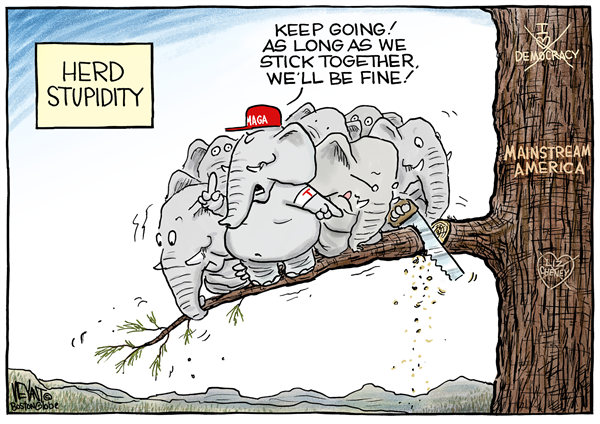Seeing the world in black and white
Brown University
Since the 1950s, political scientists have theorized that political polarization — increased numbers of “political partisans” who view the world with an ideological bias — is associated with an inability to tolerate uncertainty and a need to hold predictable beliefs about the world.
But little is known
about the biological mechanisms through which such biased perceptions arise.
To investigate that question, scientists at Brown University measured and compared the brain activity of committed partisans (both liberals and conservatives) as they watched real political debates and news broadcasts.
In a recent study, they found that polarization
was indeed exacerbated by intolerance of uncertainty: liberals with this trait
tended to be more liberal in how they viewed political events, conservatives
with this trait tended to be more conservative.
Yet the same neural
mechanisms was at work, pushing the partisans into their different ideological
camps.
“This is the first research we know of that has linked intolerance to uncertainty to political polarization on both sides of the aisle,” said study co-author Oriel FeldmanHall, an assistant professor of cognitive, linguistic and psychological sciences at Brown.
“So whether a person in 2016 was a strongly committed Trump
supporter or a strongly committed Clinton supporter, it doesn’t matter. What
matters is that an aversion to uncertainty only exacerbates how similarly two
conservative brains or two liberal brains respond when consuming political
content.”
Jeroen van Baar,
study co-author and a former post-doctoral researcher at Brown, said the
findings are important because they show that factors other than political
beliefs themselves can influence individuals’ ideological biases.
“We found that polarized perception — ideologically warped perceptions of the same reality — was strongest in people with the lowest tolerance for uncertainty in general,” said van Baar, who is now a research associate at Trimbos, the Netherlands Institute of Mental Health and Addiction.
“This shows that some
of the animosity and misunderstanding we see in society is not due to
irreconcilable differences in political beliefs, but instead depends on
surprising — and potentially solvable — factors such as the uncertainty people
experience in daily life.”
The study was
published online in the journal PNAS on Thurs., May 13.
To examine whether
and how intolerance for uncertainty shapes how political information is
processed in the brain, the researchers recruited 22 committed liberals and 22
conservatives. They used fMRI technology to measure brain activity while
participants watched three types of videos: a neutrally worded news segment on
a politically charged topic, an inflammatory debate segment and a non-political
nature documentary.
After the viewing
session, participants answered questions about their comprehension and judgment
of the videos and completed an extensive survey with five political and three
cognitive questionnaires designed to measure traits like intolerance of
uncertainty.
“We used relatively
new methods to look at whether a trait like intolerance of uncertainty
exacerbates polarization, and to examine if individual differences in patterns
of brain activity synchronize to other individuals that hold like-minded
beliefs,” FeldmanHall said.
When the researchers analyzed participants’ brain activity while processing the videos, they found that neural responses diverged between liberals and conservatives, reflecting differences in the subjective interpretation of the footage.
People who
identified strongly as liberal processed political content much in the same way
and at the same time — which the researchers refer to as neural synchrony.
Likewise, the brains of those who identified as conservative were also in sync
when processing political content.
“If you are a
politically polarized person, your brain syncs up with like-minded individuals
in your party to perceive political information in the same way,” FeldmanHall
said.
This polarized
perception was exacerbated by the personality trait of intolerance of
uncertainty. Those participants — of any ideology — who were less tolerant to
uncertainty in daily life (as reported on their survey responses) had more
ideologically polarized brain responses than those who are better able to
tolerate uncertainty.
“This suggests that
aversion to uncertainty governs how the brain processes political information
to form black-and-white interpretations of inflammatory political content,” the
researchers wrote in the study.
Interestingly, the
researchers did not observe the polarized perception effect during a
non-political video or even during a video about abortion presented in a
neutral, non-partisan tone.
“This is key because
it implies that ‘liberal and conservative brains’ are not just different in
some stable way, like brain structure or basic functioning, as other
researchers have claimed, but instead that ideological differences in brain
processes arise from exposure to very particular polarizing material,” van Baar
said. “This suggests that political partisans may be able to see eye to eye —
provided we find the right way to communicate.”
David J. Halpern of
New York University and the University of Pennsylvania was an additional study
author.
The research was
supported by a Brown University seed grant and by National Institutes of Health
COBRE Grant P20GM103645.
